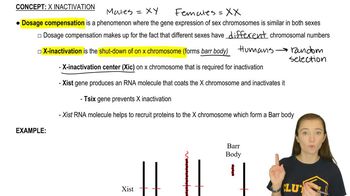Table of contents
- 1. Introduction to Genetics51m
- 2. Mendel's Laws of Inheritance3h 37m
- 3. Extensions to Mendelian Inheritance2h 41m
- 4. Genetic Mapping and Linkage2h 28m
- 5. Genetics of Bacteria and Viruses1h 21m
- 6. Chromosomal Variation1h 48m
- 7. DNA and Chromosome Structure56m
- 8. DNA Replication1h 10m
- 9. Mitosis and Meiosis1h 34m
- 10. Transcription1h 0m
- 11. Translation58m
- 12. Gene Regulation in Prokaryotes1h 19m
- 13. Gene Regulation in Eukaryotes44m
- 14. Genetic Control of Development44m
- 15. Genomes and Genomics1h 50m
- 16. Transposable Elements47m
- 17. Mutation, Repair, and Recombination1h 6m
- 18. Molecular Genetic Tools19m
- 19. Cancer Genetics29m
- 20. Quantitative Genetics1h 26m
- 21. Population Genetics50m
- 22. Evolutionary Genetics29m
2. Mendel's Laws of Inheritance
Monohybrid Cross
Problem 17b
Textbook Question
In cats, tortoiseshell coat color appears in females. A tortoiseshell coat has patches of dark brown fur and patches of orange fur that each in total cover about half the body but have a unique pattern in each female. Male cats can be either dark brown or orange, but a male cat with tortoiseshell coat is rarely produced. Two sample crosses between males and females from pure-breeding lines produced the tortoiseshell females shown.
Cross I P: dark brown male × orange female
F₁: orange males and tortoiseshell females
Cross II P: orange male × dark brown female
F₁: dark brown males and tortoiseshell females
Why are tortoiseshell cats female?
 Verified step by step guidance
Verified step by step guidance1
span>Step 1: Understand the genetic basis of coat color in cats. The coat color in cats is linked to the X chromosome. The gene responsible for the orange and dark brown colors is located on the X chromosome.</span
span>Step 2: Recognize that females have two X chromosomes (XX), while males have one X and one Y chromosome (XY). This means females can have two different alleles for coat color, while males can only have one.</span
span>Step 3: In tortoiseshell cats, one X chromosome carries the allele for orange fur, and the other X chromosome carries the allele for dark brown fur. This results in a mosaic pattern of fur color due to X-inactivation, where one of the X chromosomes is randomly inactivated in each cell.</span
span>Step 4: Since males have only one X chromosome, they can only be either orange or dark brown, depending on the allele present on their single X chromosome. They cannot be tortoiseshell because they lack the second X chromosome needed for the mosaic pattern.</span
span>Step 5: The rare occurrence of tortoiseshell males is usually due to genetic anomalies, such as Klinefelter syndrome (XXY), where the male has an extra X chromosome, allowing for the tortoiseshell pattern to appear.</span
Recommended similar problem, with video answer:
 Verified Solution
Verified SolutionThis video solution was recommended by our tutors as helpful for the problem above
Video duration:
1mPlay a video:
Was this helpful?
Key Concepts
Here are the essential concepts you must grasp in order to answer the question correctly.
X-Linked Inheritance
Tortoiseshell coat color in cats is a result of X-linked inheritance, where the genes responsible for the color are located on the X chromosome. Female cats have two X chromosomes, allowing them to express both color traits (orange and dark brown) simultaneously. In contrast, male cats have only one X chromosome, which limits their coat color to either orange or dark brown, making tortoiseshell males extremely rare.
Recommended video:
Guided course

X-Inactivation
Dosage Compensation
In female mammals, one of the two X chromosomes is randomly inactivated in a process called X-inactivation or dosage compensation. This results in a mosaic expression of the genes on the X chromosomes, leading to the characteristic patchwork of colors seen in tortoiseshell females. This phenomenon explains why tortoiseshell coloration is typically observed only in females.
Recommended video:
Guided course

Purpose of X Inactivation
Genetic Crosses and Phenotypes
The genetic crosses described in the question illustrate how different parental genotypes can produce specific offspring phenotypes. In the provided crosses, the combination of dark brown and orange parents results in tortoiseshell females due to the inheritance of different alleles from each parent. Understanding these crosses helps clarify how the tortoiseshell phenotype arises and why it is predominantly female.
Recommended video:
Guided course

Monohybrid Cross

 1:20m
1:20mWatch next
Master Monohybrid Cross with a bite sized video explanation from Kylia Goodner
Start learningRelated Videos
Related Practice

